Wet Bone Characteristics Persist in Buried Bone after 10 Weeks: Implications for Forensic Anthropology
Abstract
:1. Introduction
- How long within a 10-week period does bone maintain its wet properties and its composition after death?
- How does fracture morphology change macroscopically and microscopically in the first ten weeks?
2. Materials and Methods
2.1. Materials
2.2. Fracture Reproduction
2.3. Analytical Methods
2.3.1. Macroscopic Analysis
- The term splintering was used in this study to describe small layers of bone detaching fully or partially in a different manner than peeling or flaking (Figure 1).
2.3.2. Biomechanical Analysis
2.3.3. Microscopic Analysis
- Collagen fibre pull-outs in areas of delamination at the convex side of the bone;
- Grooving on the fractured edge/surface on a microscopic level;
- Periosteal tearing, due to grooving or string-like appearances of the periosteal surface;
- Subsurface microcracks along the surface of the fracture.
2.3.4. Fourier Transform Infrared Spectroscopy (FTIR)
2.3.5. Thermal Analysis
2.3.6. Statistical Analysis
3. Results
3.1. Deposition Environment
3.2. Buried Sample
3.2.1. Macroscopic Analysis
3.2.2. Biomechanical Analysis
3.2.3. Microscopic Analysis
3.2.4. Biophysical Characterisation
4. Discussion
4.1. Macroscopic Analysis
4.2. Biomechanical Analysis
4.3. Microscopic Analysis
4.4. FTIR
4.5. Thermal Analysis
4.6. Buried vs. Unburied
4.7. Recommendations and Limitations
5. Conclusions
Supplementary Materials
Author Contributions
Funding
Institutional Review Board Statement
Informed Consent Statement
Data Availability Statement
Acknowledgments
Conflicts of Interest
References
- Love, J.C.; Wiersema, J.M. Skeletal Trauma: An anthropological review. Acad. Forensic Pathol. 2016, 6, 463–477. [Google Scholar] [CrossRef]
- Passalacqua, N.V.; Rainwater, C.W. (Eds.) Skeletal Trauma Analysis: Case Studies in Context; John Wiley & Sons: Chichester, UK, 2015. [Google Scholar]
- Wedel, V.; Galloway, A. (Eds.) Broken Bones: Anthropological Analysis of Blunt Force Trauma; Charles C. Thomas Publisher Ltd.: Springfield, MO, USA, 2014. [Google Scholar]
- Kemp, W.L. Postmortem Change and its Effect on Evaluation of Fractures. Acad. Forensic Pathol. 2017, 6, 28–44. [Google Scholar] [CrossRef]
- Benedix, D.C. Differentiation of Fragmented Bone from South East Asia: The Histological Evidence. Ph.D. Thesis, University of Tennessee, Knoxville, TN, USA, 2004. [Google Scholar]
- Hillier, M.L.; Bell, L.S. Differentiating Human Bone from Animal Bone: A Review of Histological Methods. J. Forensic Sci. 2007, 52, 249–263. [Google Scholar] [CrossRef]
- Morris, Z.H. Quantitative and spatial analysis of the microscopic bone structures of deer (Odocoileus virginianus), dog (Canis familiaris), and pig (Sus scrofa domesticus). Master’s Thesis, Graduate School Louisiana State University, Baton Rouge, LA, USA, 2007. [Google Scholar]
- Manzella, A. Investigating skeletal trauma in the early Post-mortem Interval. Master’s Thesis, Cranfield University, Cranfield, UK, 2021. Available online: https://mta.cranfield.ac.uk/handle/1826.1/16552 (accessed on 1 June 2023).
- Linde, F.; Sørensen, H.C.F. The effect of different storage methods on the mechanical properties of trabecular bone. J. Biomech. 1993, 26, 1249–1252. [Google Scholar] [CrossRef]
- Jung, H.J.; Vangipuram, G.; Fisher, M.B.; Yang, M.; Hsu, S.; Bianchi, J.; Ronholdt, C.; Woo, S.L. The effects of multiple freeze–thaw cycles on the biomechanical properties of the human bone- patellar tendon-bone allograft. J. Orthop. Res. 2011, 29, 1193–1198. [Google Scholar] [CrossRef]
- Hansen, U.; Zioupos, P.; Simpson, R.; Currey, J.D.; Hynd, D. The Effect of Strain Rate on the Mechanical Properties of Human Cortical Bone. J. Od Biomech. Eng. 2008, 130, 011011. [Google Scholar] [CrossRef]
- Isa, M.; Fenton, T.; Deland, T.; Haut, R. Assessing Impact Direction in 3-point Bending of Human Femora: Incomplete Butterfly Fractures and Fracture Surfaces. J. Forensic Sci. 2017, 63, 38–64. [Google Scholar] [CrossRef]
- Moraitis, K.; Spiliopoulou, C. Identification and Differential Diagnosis of Perimortem Blunt Force Trauma in Tubular Long Bones. Forensic Sci. Med. Pathol. 2006, 2, 221–229. [Google Scholar] [CrossRef]
- Wheatley, B.P. Perimortem or Postmortem Bone Fractures? An Experimental Study of Fracture Patterns in Deer Femora. J. Forensic Sci. 2008, 53, 69–72. [Google Scholar] [CrossRef]
- Christensen, A.M.; Passalacqua, N.V.; Bartelink, E.J. Forensic Anthropology Current Methods and Practice; Academic Press: Oxford, UK, 2014. [Google Scholar]
- Scheirs, S.; Langenhorst, W.; Malgosa, A.; Ortega-Sánchez, M.; McGlynn, H.; Santos, C.; Jordana, X.; Rodriguez-Baeza, A.; Galtés, I. Perimortem fracture pattern in ribs by blunt force trauma. Int. J. Leg. Med. 2018, 132, 1205–1213. [Google Scholar] [CrossRef]
- Moini, J. Anatomy and Physiology for Health Professionals; Jones & Bartlett Learning: Burlington, MA, USA, 2020. [Google Scholar]
- Villa, P.; Mahieu, E. Breakage patterns of human long bones. J. Hum. Evol. 1991, 21, 27–48. [Google Scholar] [CrossRef]
- Kieser, J.; Weller, S.; Swain, M.N.; Waddell, J.N.; Das, R. Compressive rib fracture: Peri-mortem and post-mortem trauma patterns in a pig model. Leg. Med. 2013, 15, 193–201. [Google Scholar] [CrossRef] [PubMed]
- Bradley, A.L.; Swain, M.V.; Waddell, J.N.; Das, R.; Athens, J.; Kieser, J.A. A comparison between rib fracture patterns in peri- and post-mortem compressive injury in a piglet model. J. Mech. Behav. Biomed. Mater. 2014, 33, 67–75. [Google Scholar] [CrossRef] [PubMed]
- Paschalis, E.P.; Mendelsohn, R.; Boskey, A.L. Infrared Assessment of Bone Quality A Review. Clin. Orthop. Relat. Res. 2011, 469, 2170–2178. [Google Scholar] [CrossRef] [PubMed]
- Wescott, D.J. Postmortem change in bone biomechanical properties: Loss of plasticity. Forensic Sci. Int. 2019, 300, 164–169. [Google Scholar] [CrossRef]
- Bonicelli, A.; Zioupos, P.; Arnold, E.; Rogers, K.D.; Xhemali, B.; Kranioti, E.F. Age related changes of rib cortical bone matrix and the application to forensic age-at-death estimation. Sci. Rep. 2021, 11, 2086. [Google Scholar] [CrossRef]
- Wang, Q.; Zhang, Y.; Lin, H.; Zha, S.; Fang, R.; Wei, X.; Fan, S.; Wang, Z. Estimation of late postmortem interval using FTIR spectroscopy and chemometrics in human skeletal remains. Forensic Sci. Int. 2017, 281, 113–120. [Google Scholar] [CrossRef]
- Woess, C.; Unterberger, S.H.; Roider, C.; Ritsch-Marte, M.; Pemberger, N.; Cemper-Kiesslich JHatzer-Grubwieser, P.; Parson, W.; Pallua, J.D. Assessing various Infrared (IR) microscopic imaging techniques for post-mortem interval evaluation of human skeletal remains. PLoS ONE 2017, 12, e0174552. [Google Scholar] [CrossRef]
- Peters, F.; Schwarz, K.; Epple, M. The structure of bone studied with synchrotron X-ray diffraction, X-ray absorption spectroscopy and thermal analysis. Thermochim. Acta 2000, 361, 131–138. [Google Scholar] [CrossRef]
- Figueiredo, M.; Fernando, A.; Martins, G.; Freitas, J.; Judas, F.; Figueiredo, H. Effect of the calcination temperature on the composition and microstructure of hydroxyapatite derived from human and animal bone. Ceram. Int. 2010, 36, 2383–2393. [Google Scholar] [CrossRef]
- Pramanik, S.; Hanif, A.S.M.; Pingguan-Murphy, B.; Osman, N.A.A. Morphological change of heat treated bovine bone: A comparative study. Materials 2013, 6, 65–75. [Google Scholar] [CrossRef]
- Ellingham, S.T.D.; Thompson, T.J.U.; Islam, M. Thermogravimetric analysis of property changes and weight loss in incinerated bone. Palaeogeogr. Palaeoclimatol. Palaeoecol. 2015, 438, 239–244. [Google Scholar] [CrossRef]
- Mkukuma, L.D.; Skakle, J.M.S.; Gibson, I.R.; Imrie, C.T.; Aspden, R.M.; Hukins, D.W.L. Effect of the proportion of organic material in bone on thermal decomposition of bone mineral: An investigation of a variety of bones from different species using thermogravimetric analysis coupled to mass spectrometry, high-temperature X-ray diffraction, and Fourier transform infrared spectroscopy. Calcif. Tissue Int. 2004, 75, 321–328. [Google Scholar] [PubMed]
- Cattaneo, C.; Cappella, A. Distinguishing between Peri- and Post-Mortem Trauma on Bone. In Taphonomy of Human Remains: Forensic Analysis of the Dead and the Depositional Environment; Schotsmans, E.M.J., Márquez-Grant, N., Forbes, S.L., Eds.; John Wiley & Sons Ltd.: Chichester, UK, 2017; pp. 352–368. [Google Scholar]
- Wu AH, B.; Christenson, R.H. Analytical and assay issues for use of cardiac troponin testing for risk stratification in primary care. Clin. Biochem. 2013, 46, 969–978. [Google Scholar] [CrossRef] [PubMed]
- Kieser, D.C.; Kanade, S.; Waddell NJm Kieser, J.A.; Theis, J.; Swain, M.V. The deer femur—A morphological and biomechanical animal model of the human femur. Bio-Med. Mater. Eng. 2014, 24, 1693–1703. [Google Scholar] [CrossRef]
- Dent, B.B.; Forbes, S.L.; Stuart, B.H. Review of human decomposition processes in soil. Environ. Geol. 2004, 45, 576–585. [Google Scholar] [CrossRef]
- Janaway, R.C.; Percival, S.L.; Wilson, A.S. Decomposition of Human Remains. In Microbiology and Aging Clinical Manifestations; Percival, R.C., Ed.; Springer: New York, NY, USA, 2009; pp. 313–334. [Google Scholar]
- Collins, M.J.; Nielsen-Marsh, C.M.; Hiller, J.; Smith, C.I.; Roberts, J.P.; Prigodich, R.V.; Wess, T.J.; Csapò, J.; Millard, A.R.; Turner-Walker, G. The survival of organic matter in bone: A review. Archaeometry 2002, 44, 383–394. [Google Scholar] [CrossRef]
- Nawrocki, S.P. Forensic Taphonomy. In Handbook for Forensic Anthropology and Archaeology; Blau, S., Ubelaker, D.H., Eds.; Routledge: New York, NY, USA, 2016; pp. 373–401. [Google Scholar]
- Wieberg, D.A.; Wescott, D.J. Estimating the Timing of Long Bone Fractures: Correlation Between the Postmortem Interval, Bone Moisture Content, and Blunt Force Trauma Fracture Characteristics. J. Forensic Sci. 2008, 53, 1028–1034. [Google Scholar] [CrossRef]
- Binu, V.S.; Mayya, S.S.; Dhar, M. Some basic aspects of statistical methods and sample size determination in health science research. Ayu 2014, 35, 119–123. [Google Scholar]
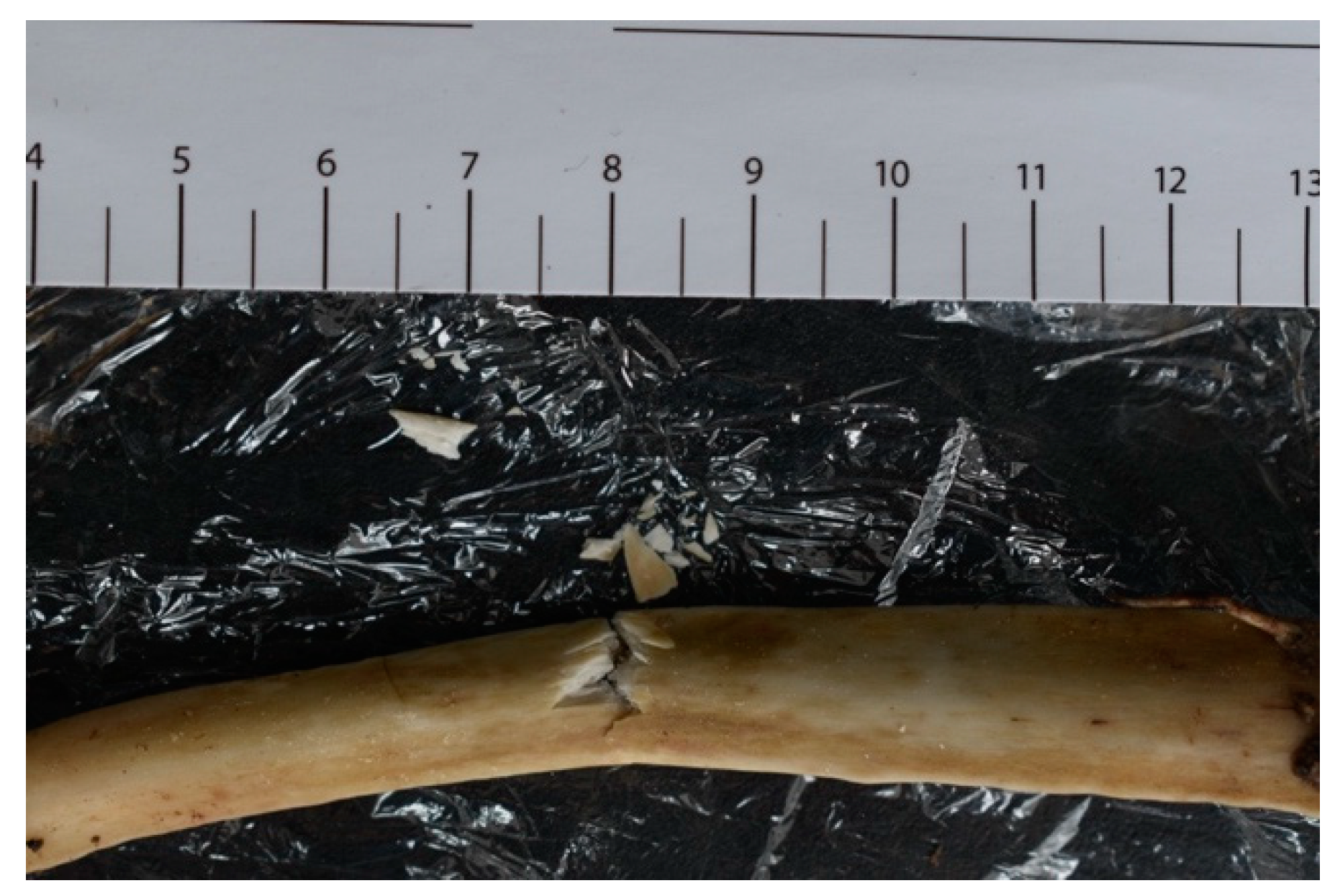
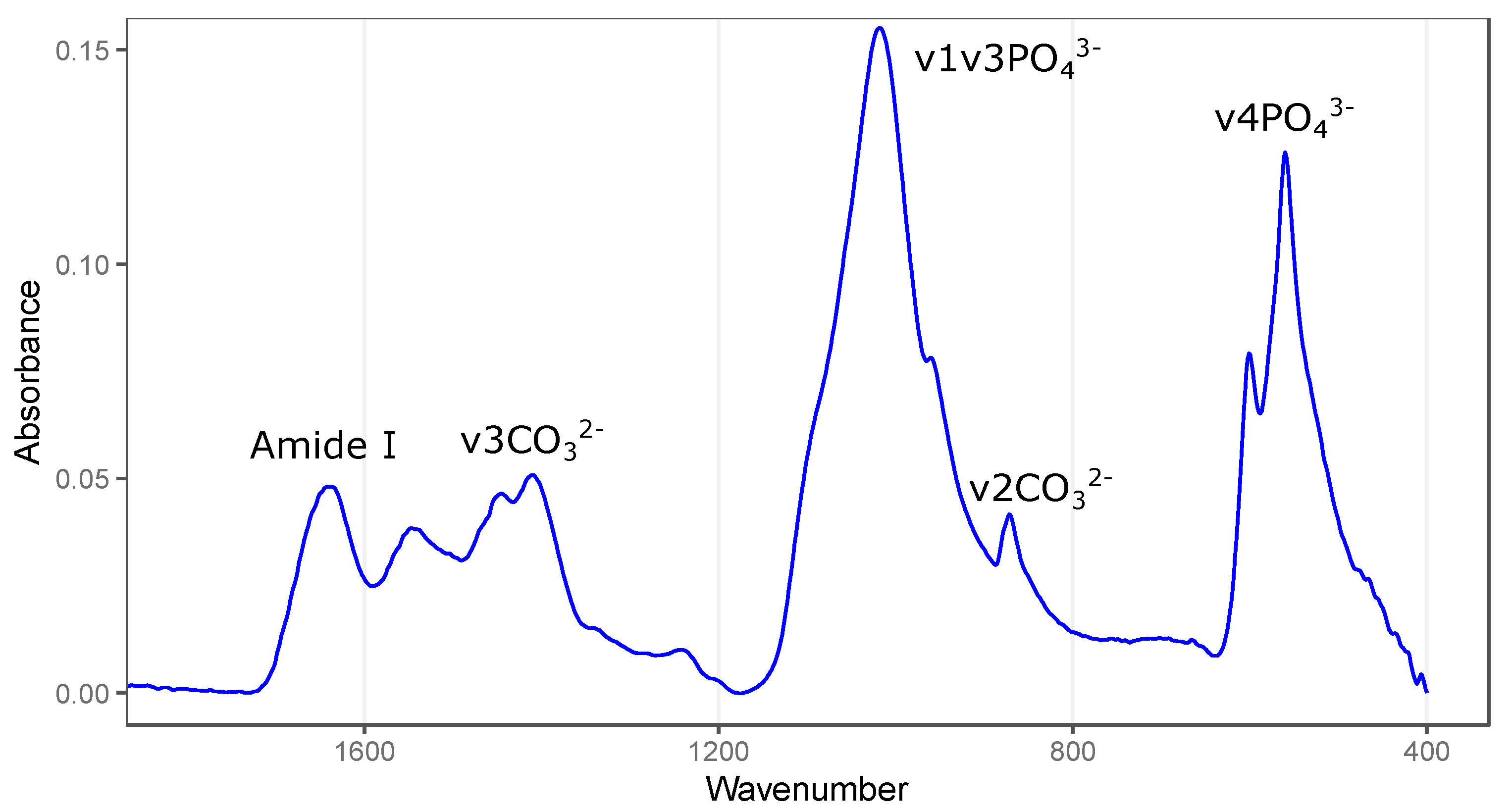

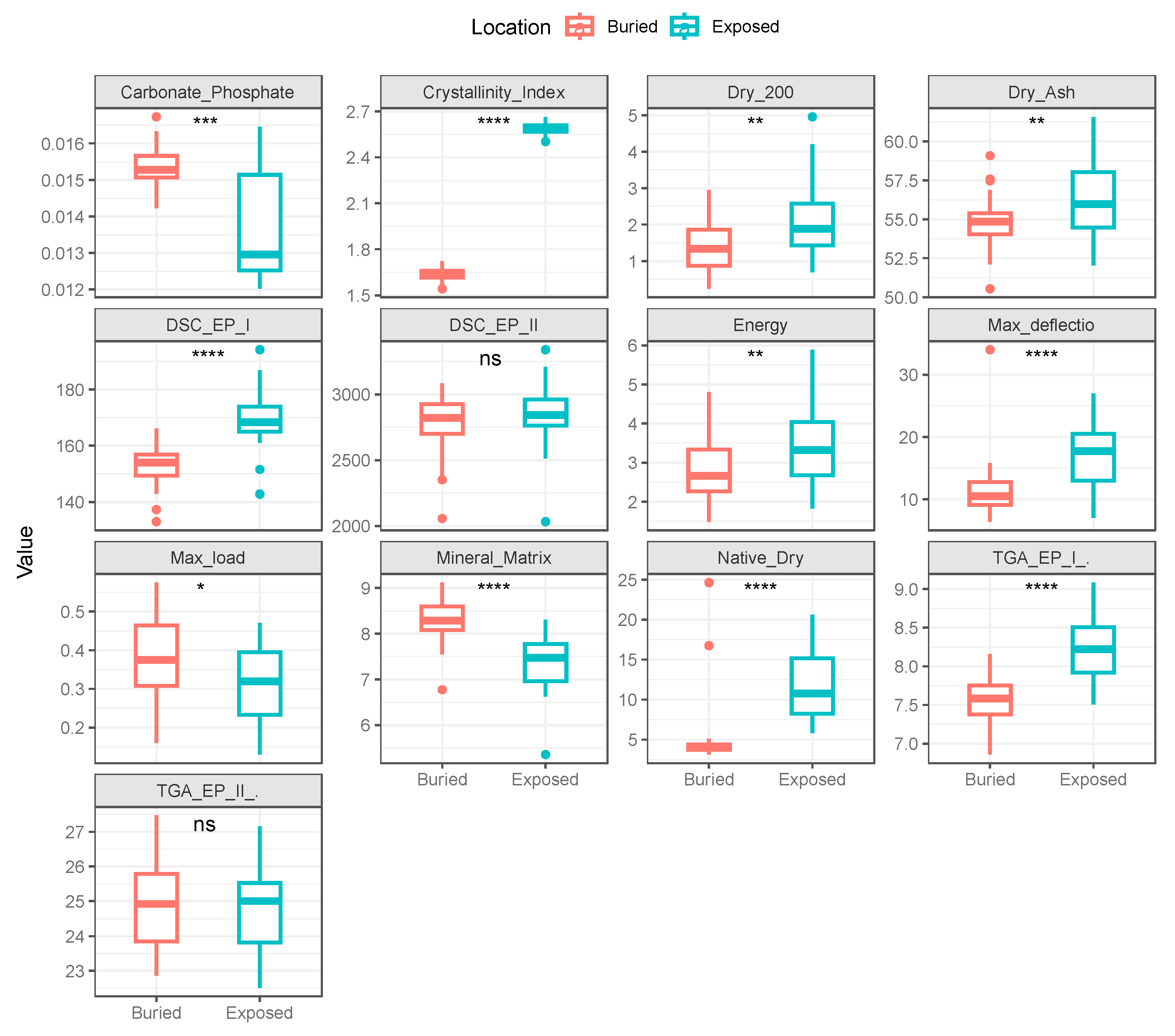
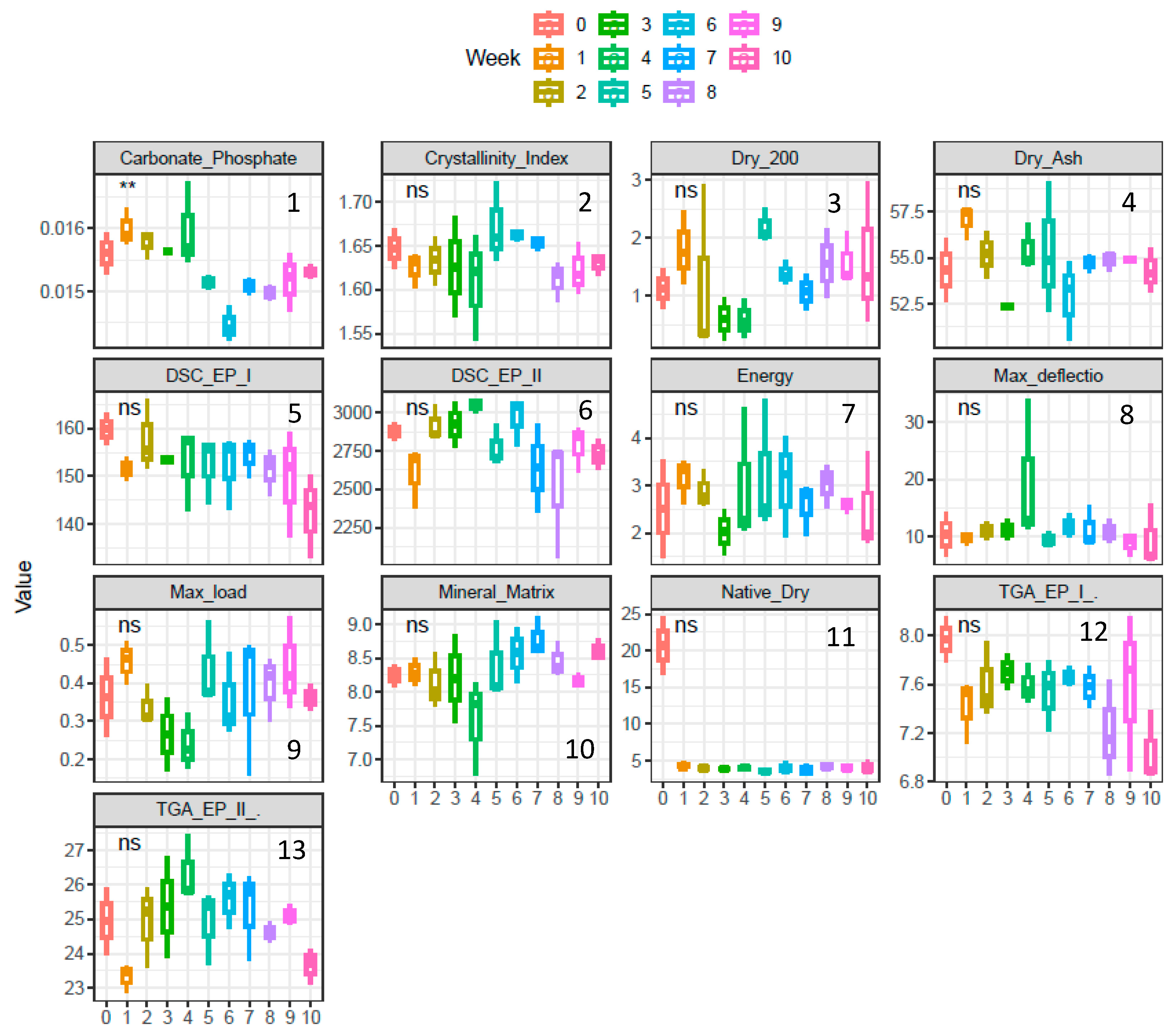
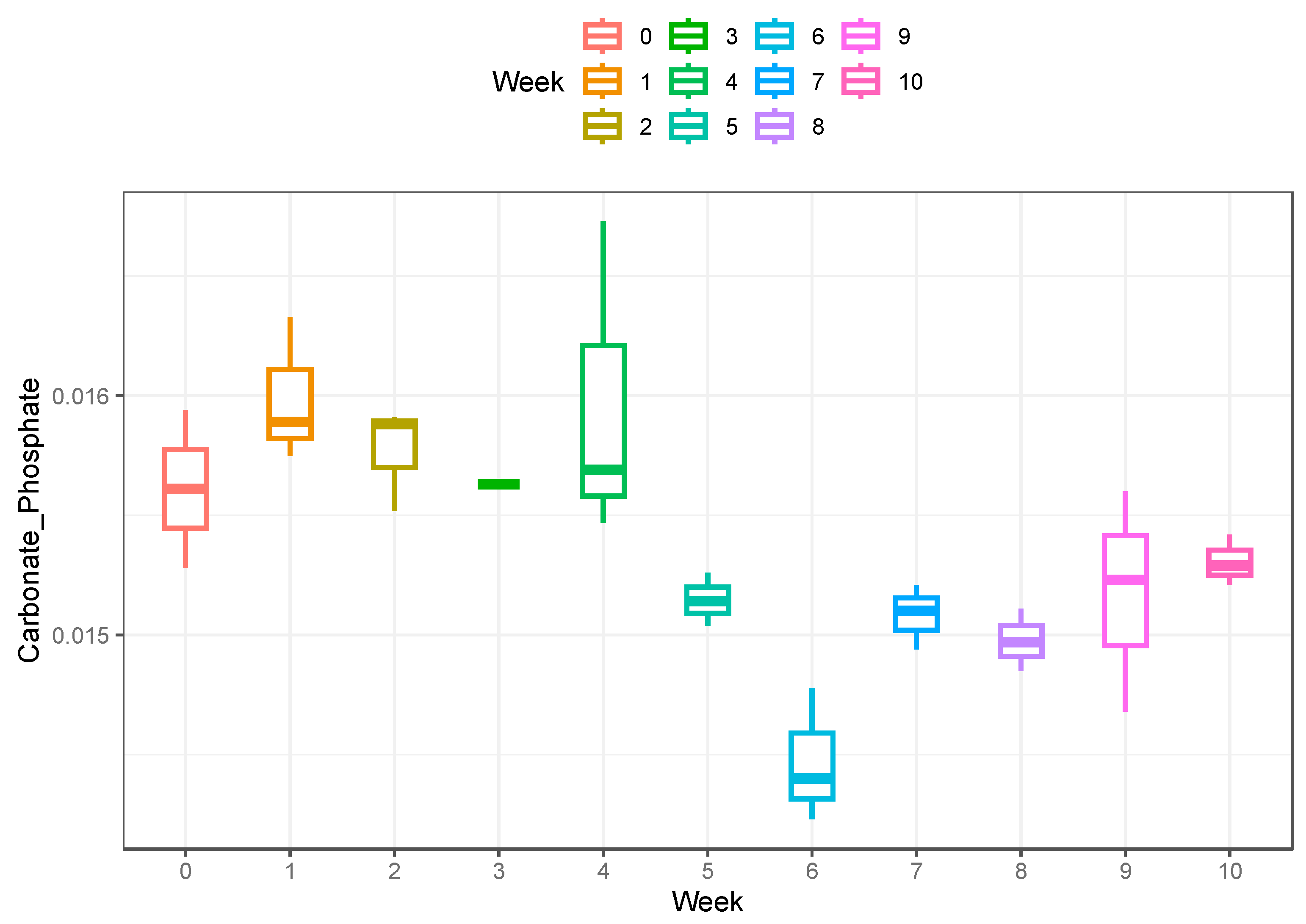
| Crystallinity Index | Carbonate-to-Phosphate Ratio | Mineral-to-Matrix Ratio |
|---|---|---|
| (565 cm−1 + 595 cm−1)/565 | ν2 Carbon/ν1ν3 Phosphate | ν1ν3 Phosphate/Amide1 |
Disclaimer/Publisher’s Note: The statements, opinions and data contained in all publications are solely those of the individual author(s) and contributor(s) and not of MDPI and/or the editor(s). MDPI and/or the editor(s) disclaim responsibility for any injury to people or property resulting from any ideas, methods, instructions or products referred to in the content. |
© 2023 by the authors. Licensee MDPI, Basel, Switzerland. This article is an open access article distributed under the terms and conditions of the Creative Commons Attribution (CC BY) license (https://creativecommons.org/licenses/by/4.0/).
Share and Cite
Maier, A.K.; Manzella, A.; Bonicelli, A.; Arnold, E.L.; Márquez-Grant, N.; Zioupos, P. Wet Bone Characteristics Persist in Buried Bone after 10 Weeks: Implications for Forensic Anthropology. Forensic Sci. 2023, 3, 491-505. https://doi.org/10.3390/forensicsci3030034
Maier AK, Manzella A, Bonicelli A, Arnold EL, Márquez-Grant N, Zioupos P. Wet Bone Characteristics Persist in Buried Bone after 10 Weeks: Implications for Forensic Anthropology. Forensic Sciences. 2023; 3(3):491-505. https://doi.org/10.3390/forensicsci3030034
Chicago/Turabian StyleMaier, Anna Katharina, Alessia Manzella, Andrea Bonicelli, Emily L. Arnold, Nicholas Márquez-Grant, and Peter Zioupos. 2023. "Wet Bone Characteristics Persist in Buried Bone after 10 Weeks: Implications for Forensic Anthropology" Forensic Sciences 3, no. 3: 491-505. https://doi.org/10.3390/forensicsci3030034
APA StyleMaier, A. K., Manzella, A., Bonicelli, A., Arnold, E. L., Márquez-Grant, N., & Zioupos, P. (2023). Wet Bone Characteristics Persist in Buried Bone after 10 Weeks: Implications for Forensic Anthropology. Forensic Sciences, 3(3), 491-505. https://doi.org/10.3390/forensicsci3030034







